Names Pf Prime Cuts of Beef
Cutting and Processing Meats
Primal, Sub-primal, and Secondary Cuts
Beef
The beef animal is broken down into sides. A side is one-half of a that has been split lengthwise from the neck to the tail. The side can then be split into the front quarter and hind quarter. This cut is made between the 12th and 13th ribs counting from the front of the animal. The beef front quarter is heavily exercised, resulting in an abundance of connective tissue. Moist heat cooking is required on the majority of the sub-primals from the front quarter, with the major exception being the 7-bone rib (prime rib). The hind quarter of beef contains mostly sub-primals that can be prepared using dry heat.
Figure 17 illustrates the primal, sub-primal, and retail cuts of beef.
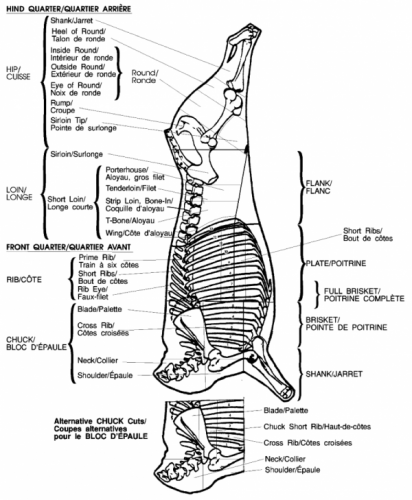
Beef Front Quarter: The beef front quarter contains four primal cuts, the brisket, foreshank, rib, and chuck (square chuck). The chuck is separated by first cutting across the carcass between the 5th and 6th ribs, which separates the chuck, brisket, and shank from the rib and plate. The second cut passes at a point slightly above the elbow joint and through the cartilage below the first (1st) rib and sternum, and separates the chuck from the brisket and shank. The brisket is further separated from the shank by following the natural contour of the elbow bone. The rib is separated from the plate by a straight cut passing across the ribs at right angles to the first cut at a point slightly below the centre of the rib cage.
The primals are then processed into sub-primals by following the cutting lines as shown in Figure 18 and Table 24.
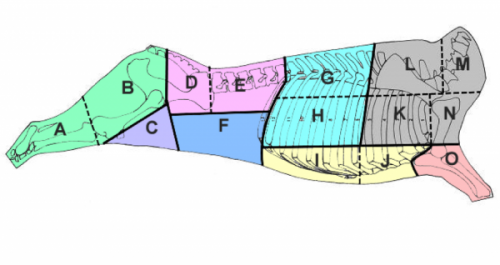
| Primal | Sub-Primal |
| Rib | Short rib (H) 7-bone rib (G) |
| Square chuck | Neck (M) Blade (L) Shoulder (N) Cross rib (K) |
| Brisket | Brisket point (J) Brisket plate (I) |
| Fore shank | No further break down required (O) |
From these sub-primals, further usable portions are processed and retail cuts prepared for the consumer.
Beef Hind Quarter: The beef hind quarter is broken down into four primal cuts, the flank, the long loin, the hip, and the sirloin tip. The flank is separated by a straight cut passing approximately parallel to the lumbar backbone (lumbar vertebrae), beginning in close proximity to or through the flank lymph node (prefemoral), and from the plate by a cut passing between the 12th and 13th ribs and cartilage. The hip is separated from the long loin by a straight cut that passes in front of the rump knuckle bone, thereby cutting the pelvic bone into approximately two equal parts. The sirloin tip is then separated from the hip by a "V-shaped" cut beginning approximately at the knee cap, following the full length of the leg bone up to the rump knuckle bone, then towards the flank lymph node.
The primals are then processed into sub-primals as shown in Figure 18 and Table 25.
| Primal | Sub-Primal |
| Flank | No further break down required (F) |
| Long loin | Short loin (E) Sirloin butt (D) |
| Hip | Inside round (B) Outside round (B-opposite side of bone) Hind shank (A) |
| Sirloin tip | No further break down (C) |
Breakdown of sub-primals into retail and wholesale cuts
From the sub-primals, secondary or portion cuts are obtained. In most cases, there are a number of different secondary cuts that can be obtained from each sub-primal. In addition, there are often different names for the same cut used in the retail, wholesale, or restaurant industry. Table 26 shows the retail and restaurant cuts that come from each of the beef sub-primals.
| Sub-Primal | Retail Meat Sales Cuts | Restaurant Cuts | Alternate Names |
| Short rb | Short ribs simmering (bone in or boneless) | Short ribs | |
| 7-bone rib | Prime rib over roast Standing rib oven roast | Prime rib | |
| Prime rib grillings steak | Rib steak | Côte de boeuf | |
| Ribeye grilling steak | Ribeye | Delmonico | |
| Beef ribs(cut from prime rib) | Finger bones | Beef back ribs | |
| Blade | Bottom blade | Chuckeye roll | |
| Top blade | Flat iron | Mock tender | |
| Cross rib | Cross rib (pot roast or marinating steak) | Short ribs, boneless short ribs | Chuck short rib |
| Beef ribs(cut from the cross rib) | Shoulder clod | ||
| Bolo | |||
| Deluxe 4-bone rib | |||
| Flat rib | |||
| Brisket point | Brisket pot roast | Corned beef | |
| Stew beef | |||
| Medium ground beef | |||
| Neck | Lean ground beef | ||
| Fore shank | Stew beef | Shin meat for consommé |
| Sub-Primal | Retail Meat Sales Cuts | Restaurant Cuts | Alternate Names |
| Flank | Flank marinating steak | Flank steak | |
| Flank steak London broil | |||
| Lean ground beef | |||
| Short loin | Porterhouse grilling steak | Porterhouse | |
| T-bone grilling steak | T-bone | ||
| Wing grilling steak | Club steak | ||
| Tenderloin grilling steak | Filet, Fillet mignon, medallion | Tournedo, Chateaubriand, Mignonette | |
| Striploin grilling steak | New York | Top loin | |
| Sirloin butt | Top sirloin (grilling steak and oven roast) | Sirloin steak | |
| Sirloin cap grilling steak | |||
| Bottom sirloin grilling steak | Tri tip | ||
| Tenderloin butt grilling steak | Chateaubriand, fillet mignon | ||
| Inside round | Inside round over roast Inside round marinating steak | Top round | Baron, top side |
| Outside round | Outside round over roast | Bottom round | Gooseneck, silverside, outside flat |
| Outside round marinating steak | Rouladen | ||
| Eye of round oven roast | |||
| Eye of round marinating steak | Swiss steak | ||
| Heel of round (stew or ground) | |||
| Sirloin tip | Sirloin tip over roast | Peeled knuckle | |
| Sirloin tip marinating steak | Ball tip | ||
| Round tip | |||
| Thick flank | |||
| Hind shank | Beef shank (crosscut) | Osso-bucco | |
| Stew beef | Shin meat for consommé | ||
| Lean ground beef |
The Beef Information Centre provides a poster (Figure 19) that outlines the cuts of beef. It can be downloaded from their resource page.
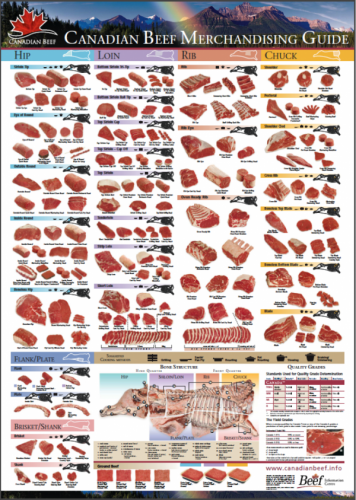
The CFIA meat cuts manual is an additional resource that shows each beef cut and location in great detail. It can be accessed on the CFIA website.Table 26 shows the cooking potential for cuts from the different beef primals. Generally, the cuts from the same primal are suited for similar cooking methods. Exceptions have been noted.
| Hind Quarter Primal | Cooking Potential | Notes (Exceptions) |
| Flank | Moist heat | The flank steak, which can be and cooked using dry heat |
| Long loin | Dry heat | |
| Hip | Dry heat | The hind shank and heel of round, which have an abundance of collagen, making them ideal for stewing meat |
| Sirloin tip | Dry heat | |
| Front Quarter Primal | ||
| Rib | Dry heat | |
| Square chuck | Moist heat | Aside from one of the top blade muscles, which can have the heavy collagen removed and be portioned into flat iron steaks, which can be prepared using dry heat |
| Brisket | Moist heat | |
| Fore shank | Moist heat |
Veal
Muscle or flesh of a veal carcass ranges in colour from pink (or lighter) to red. To be classified as veal by CFIA standards, the dressed carcass must weigh less than 180 kg (396 lb). Veal is most commonly sold in vacuum-packed sub-primals. It is seldom dry aged due to the lack of fat cover on the animal. Figure 20 shows the CFIA veal cuts.
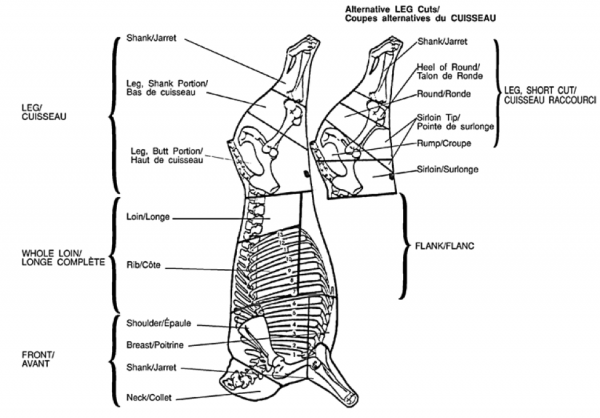
There are six primal cuts from a side of veal, the leg, flank, loin, breast, shoulder, and front shank. The front, containing the shoulder, breast, and front shank, is separated from the whole loin and flank by cutting between the 6th and 7th ribs. The breast and shank are further separated by a cut that goes from just above the joint of the arm bone perpendicular to the ribs. The shank is then separated by following the natural separation of the arm bone. The leg is separated from the whole loin and flank by a straight cut that passes in front of the pin bone. The flank is then separated from the whole loin by a straight cut approximately parallel to the backbone, passing at a point slightly above the cartilage of the 12th rib.
The primals are further broken down into sub-primals as shown in Figure 21 and Table 28. Note that there are two ways of cutting the leg into sub-primals accepted by CFIA.
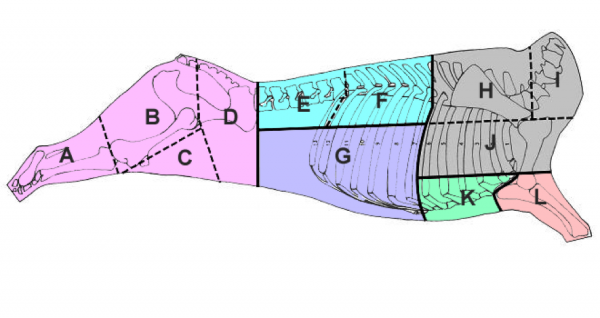
| Primal | Sub-primal |
| Veal leg | Leg cuts (sub-primal) and Alternative leg cuts (sub-primals) |
| Shank (A) and Shank (A) | |
| Leg, shank portion (B, portion of C) and Heel of round (bottom portion of B), Round (B) | |
| Leg, butt portion (D, portion of C) and Sirloin Tip (C), Rump (top portion of B), Sirloin (D) | |
| Veal flank | No further breakdown (G) |
| Veal loin | Loin (E) |
| Rib (or rack) (F) | |
| Veal shoulder | Shoulder arm (J) |
| Shoulder blade (H) | |
| Neck (I) | |
| Veal breast | No further breakdown (K) |
| Veal front shank | No further breakdown (L) |
The sub-primals are cut further into retail or restaurant cuts as shown in Table 29.
| Primal | Sub-Primal | Retail Meat Sales Cuts | Restaurant Cuts | Alternate Names |
| Veal leg | Shank | Veal shank crosscut | Osso-bucco | |
| Leg, butt portion | Veal inside round | Cutlets, | Veal top round | |
| Veal outside round | Veal bottom round | |||
| Veal leg cutlets (breaded) | Schnitzel | |||
| Sirloin tip | Veal sirloin tip | Veal knuckle | ||
| Sirloin | Veal top sirloin | Veal hip | ||
| Veal flank | Ground, sausage | Ground veal | ||
| Veal loin | Loin | Veal loin roast | Veal strip loin | Saddle |
| Veal loin chops | Veal T-bone | |||
| Veal tenderloin | Veal tenderloin, medallions | |||
| Rib | Veal rib chops | Veal chop | ||
| Veal rib roast | Veal rack | Hotel rack | ||
| Veal shoulder | Veal shoulder arm | Shoulder roast, chops | Square chuck | |
| Veal shoulder blade | Cubed veal, ground veal | |||
| Veal breast | Veal breast, rolled, stuffed | Breast of veal, cubed veal, ground veal | Brisket | |
| Veal front shank | Veal shank crosscut | Osso-bucco |
The Veal Farmers of Ontario provide a comprehensive veal cut chart (Figure 22) for download.
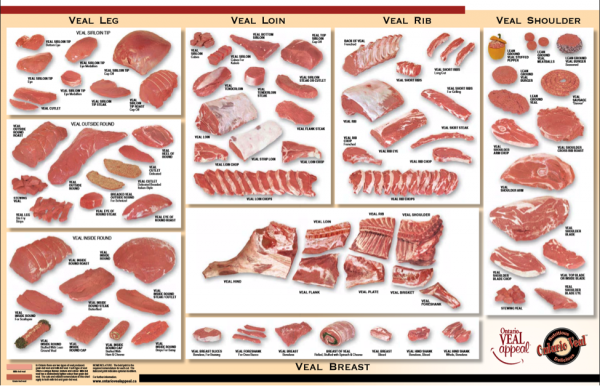
The CFIA meat cuts manual is an additional resource that shows each veal cut and location in great detail. It can be accessed on the CFIA website.
Source: https://opentextbc.ca/meatcutting/chapter/primal-sub-primal-and-secondary-cuts/
0 Response to "Names Pf Prime Cuts of Beef"
Post a Comment